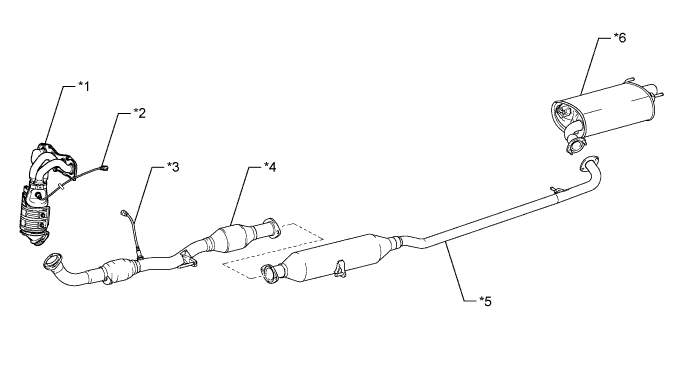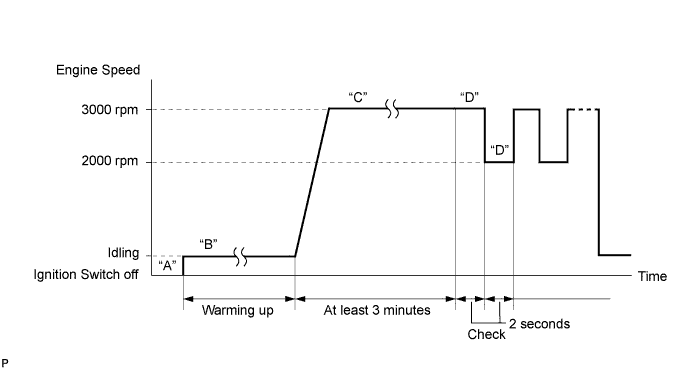Dtc P0420 Catalyst System Efficiency Below Threshold (Bank 1)
DESCRIPTION
CATALYST LOCATION
CONFIRMATION DRIVING PATTERN
CONDITIONING FOR SENSOR TESTING
INSPECTION PROCEDURE
CHECK ANY OTHER DTCS OUTPUT (IN ADDITION TO DTC P0420)
PERFORM ACTIVE TEST USING INTELLIGENT TESTER (CONTROL THE INJECTION VOLUME FOR A/F SENSOR)
INSPECT FOR EXHAUST GAS LEAK
REPLACE EXHAUST MANIFOLD CONVERTER SUB-ASSEMBLY (TWC: FRONT CATALYST)
INSPECT FOR EXHAUST GAS LEAK
INSPECT FOR EXHAUST GAS LEAK
DTC P0420 Catalyst System Efficiency Below Threshold (Bank 1) |
DESCRIPTION
The ECM uses sensors mounted in front of and behind the Three-Way Catalytic Converter (TWC) to monitor its efficiency.The first sensor, the air fuel ratio sensor, sends pre-catalyst information to the ECM. The second sensor, the heated oxygen sensor, sends post-catalyst information to the ECM.In order to detect any deterioration in the three-way catalytic converter, the ECM calculates the oxygen storage capacity of the three-way catalytic converter. This calculation is based on the voltage output of the heated oxygen sensor while performing active air fuel ratio control.The oxygen storage capacity value is an indication of the oxygen storage capacity of the three-way catalytic converter. When the vehicle is being driven with a warm engine, active air fuel ratio control is performed for approximately 15 to 20 seconds. When it is performed, the ECM deliberately sets the air fuel ratio to lean or rich levels. If the cycle of the waveform for the heated oxygen sensor is long, the oxygen storage capacity is great. There is a direct correlation between the heated oxygen sensor and the oxygen storage capacity of the three-way catalytic converter.The ECM uses the oxygen storage capacity value to determine the state of the three-way catalytic converter. If any deterioration has occurred, it illuminates the MIL and sets the DTC.DTC No.
| DTC Detection Condition
| Trouble Area
|
P0420
| Oxygen storage capacity value smaller than standard value under active air fuel ratio control
(2 trip detection logic)
| - Gas leak from exhaust system
- Air fuel ratio sensor (sensor 1)
- Heated oxygen sensor (sensor 2)
- Exhaust manifold converter sub-assembly (TWC: Front catalyst)
- Front exhaust pipe assembly (TWC: Rear catalyst)
|
- HINT:
- Sensor 1 refers to the sensor closest to the engine assembly.
- Sensor 2 refers to the sensor farthest away from the engine assembly.
CATALYST LOCATION
Text in Illustration*1
| Exhaust Manifold Converter Sub-assembly (TWC: Front Catalyst)
| *2
| Air Fuel Ratio Sensor (Sensor 1)
|
*3
| Heated Oxygen Sensor (Sensor 2)
| *4
| Front Exhaust Pipe Assembly (TWC: Rear Catalyst)
|
*5
| Center Exhaust Pipe Assembly
| *6
| Tail Exhaust Pipe Assembly
|
CONFIRMATION DRIVING PATTERN
- HINT:
- Performing this confirmation driving pattern will activate the catalyst monitor. This is very useful for verifying the completion of a repair.
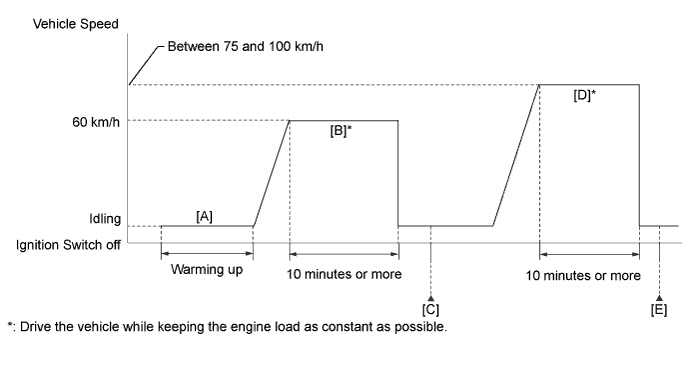
- Connect the intelligent tester to the DLC3.
- Turn the ignition switch to ON.
- Turn the tester on.
- Clear DTCs.
- Turn the ignition switch off and wait for at least 30 seconds.
- Turn the ignition switch to ON and turn the tester on.
- Start the engine and warm it up until the engine coolant temperature is 75°C (167°F) or higher [A].
- Drive the vehicle at approximately 60 km/h (38 mph) for 10 minutes or more [B].
- HINT:
- Drive the vehicle while keeping the engine load as constant as possible.
- CAUTION:
- When performing the confirmation driving pattern, obey all speed limits and traffic laws.
- Enter the following menus: Powertrain / Engine and ECT / DTC [C].
- Read the pending DTCs.
- HINT:
- If a pending DTC is output, the system is malfunctioning.
- If a pending DTC is not output, perform the following procedure.
- Enter the following menus: Powertrain / Engine and ECT / Utility / All Readiness.
- Input the DTC: P0420.
- Check the DTC judgment result.
Tester Display
| Description
|
NORMAL
| - DTC judgment completed
- System normal
|
ABNORMAL
| - DTC judgment completed
- System abnormal
|
INCOMPLETE
| - DTC judgment not completed
- Perform driving pattern after confirming DTC enabling conditions
|
UNKNOWN
| - Unable to perform DTC judgment
- Number of DTCs which do not fulfill DTC preconditions has reached ECU memory limit
|
- HINT:
- If the judgment result shows NORMAL, the system is normal.
- If the judgment result shows ABNORMAL, the system has a malfunction.
- If the judgment result shows INCOMPLETE or UNKNOWN, perform steps [D] through [E].
- Drive the vehicle at a speed between 75 and 100 km/h (47 and 63 mph) for 10 minutes or more [D].
- HINT:
- Drive the vehicle while keeping the engine load as constant as possible.
- CAUTION:
- When performing the confirmation driving pattern, obey all speed limits and traffic laws.
- Check the DTC judgment result again [E].
CONDITIONING FOR SENSOR TESTING
- HINT:
- Perform the operation with the engine speeds and time durations described below prior to checking the waveforms of the air fuel ratio sensor and heated oxygen sensor. This is in order to activate the sensors sufficiently to obtain the appropriate inspection results.
- (a) Connect the intelligent tester to the DLC3 (Step "A").
- (b) Start the engine and warm it up with all the accessories switched off until the engine coolant temperature stabilizes (Step "B").
- (c) Run the engine at an engine speed of between 2500 rpm and 3000 rpm for at least 3 minutes (Step "C").
- (d) While running the engine at 3000 rpm for 2 seconds and 2000 rpm for 2 seconds, check the waveforms of the air fuel ratio and heated oxygen sensors using the intelligent tester (Step "D").
- HINT:
- If either of the voltage outputs of the air fuel ratio or heated oxygen sensors does not fluctuate, or there is noise in the waveform of either sensor, the sensor may be malfunctioning.
- If the voltage outputs of both the sensors remain lean or rich, the air fuel ratio may be extremely lean or rich. In such cases, perform the following menu items: Powertrain / Engine and ECT / Active Test / Control the Injection Volume for A/F Sensor.
- If the three-way catalytic converter has deteriorated, the heated oxygen sensor (located behind the three-way catalytic converter) voltage output fluctuates up and down frequently, even under normal driving conditions (active air fuel ratio control is not performed).
INSPECTION PROCEDURE
- HINT:
- Malfunctioning areas can be identified by performing the Control the Injection Volume for A/F Sensor Active Test. The Control the Injection Volume for A/F Sensor function can help to determine whether the air fuel ratio sensor, heated oxygen sensor and other potential trouble areas are malfunctioning.
- The following instructions describe how to conduct the Control the Injection Volume for A/F Sensor operation using the intelligent tester.
- Connect the intelligent tester to the DLC3.
- Start the engine.
- Turn the tester on.
- Warm up the engine at an engine speed of 2500 rpm for approximately 90 seconds.
- Enter the following menus: Powertrain / Engine and ECT / Active Test / Control the Injection Volume for A/F Sensor.
- Perform the Active Test operation with the engine in an idling condition (press the RIGHT or LEFT button to change the fuel injection volume).
- Monitor the output voltages of the air fuel ratio and heated oxygen sensors (AFS Voltage B1S1 and O2S B1S2) displayed on the tester.
- HINT:
- The Control the Injection Volume for A/F Sensor operation lowers the fuel injection volume by 12.5% or increases the injection volume by 25%.
- Each sensor reacts in accordance with increases and decreases in the fuel injection volume.
Tester Display (Sensor)
| Injection Volume
| Status
| Voltage
|
AFS Voltage B1S1
(Air fuel ratio)
| +25%
| Rich
| Less than 3.1 V
|
-12.5%
| Lean
| More than 3.4 V
|
O2S B1S2
(Heated oxygen)
| +25%
| Rich
| More than 0.55 V
|
-12.5%
| Lean
| Less than 0.4 V
|
- NOTICE:
- The air fuel ratio sensor has an output delay of a few seconds and the heated oxygen sensor has a maximum output delay of approximately 20 seconds.
Case
| Air Fuel Ratio Sensor (Sensor 1)
Output Voltage
| Heated Oxygen Sensor (Sensor 2)
Output Voltage
| Main Suspected Trouble Area
|
1
| 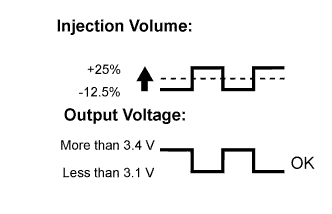
| 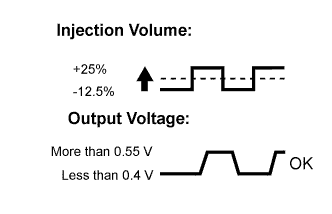
| -
|
2
| 
| 
| - Air fuel ratio sensor
- Air fuel ratio sensor heater
- Air fuel ratio sensor circuit
|
3
| 
| 
| - Heated oxygen sensor
- Heated oxygen sensor heater
- Heated oxygen sensor circuit
|
4
| 
| 
| - Fuel pressure
- Gas leakage from exhaust system
(Air fuel ratio extremely lean or rich)
|
- Following the Control the Injection Volume for A/F Sensor procedure enables technicians to check and graph the voltage outputs of both the air fuel ratio and heated oxygen sensors.
- To display the graph, enter the following menus: Powertrain / Engine and ECT / Active Test / Control the Injection Volume for A/F Sensor / AFS Voltage B1S1 and O2S B1S2; then press the graph button on the Data List screen.
- HINT:
- Read freeze frame data using the intelligent tester. The ECM records vehicle and driving condition information as freeze frame data the moment a DTC is stored. When troubleshooting, freeze frame data can be helpful in determining whether the vehicle was running or stopped, whether the engine was warmed up or not, whether the air fuel ratio was lean or rich, as well as other data recorded at the time of a malfunction.
| 1.CHECK ANY OTHER DTCS OUTPUT (IN ADDITION TO DTC P0420) |
Connect the intelligent tester to the DLC3.
Turn the ignition switch to ON.
Turn the tester on.
Enter the following menus: Powertrain / Engine and ECT / DTC.
Read the DTCs.
- Result:
Result
| Proceed to
|
DTC P0420 is output
| A
|
DTC P0420 and other DTCs are output
| B
|
- HINT:
- If any DTCs other than P0420 are output, troubleshoot those DTCs first.
| 2.PERFORM ACTIVE TEST USING INTELLIGENT TESTER (CONTROL THE INJECTION VOLUME FOR A/F SENSOR) |
Connect the intelligent tester to the DLC3.
Start the engine and warm it up.
Turn the tester on.
Run the engine at an engine speed of 2500 rpm for approximately 90 seconds.
Enter the following menus: Powertrain / Engine and ECT / Active Test / Control the Injection Volume for A/F Sensor AFS Voltage B1S1 and O2S B1S2.
Perform the Active Test operation with the engine in an idling condition (press the RIGHT or LEFT button to change the fuel injection volume).
Monitor the voltage outputs of the air fuel ratio sensor and heated oxygen sensor (AFS Voltage B1S1 and O2S B1S2) displayed on the tester.
- HINT:
- The Control the Injection Volume for A/F Sensor operation lowers the fuel injection volume by 12.5% or increases the injection volume by 25%.
- Each sensor reacts in accordance with increases and decreases in the fuel injection volume.
- The air fuel ratio sensor has an output delay of a few seconds and the heated oxygen sensor has a maximum output delay of approximately 20 seconds.
- Standard:
Tester Display
(Sensor)
| Injection Volume
| Status
| Voltage
|
AFS Voltage B1S1
(air fuel ratio)
| +25%
| Rich
| Less than 3.1 V
|
-12.5%
| Lean
| More than 3.4 V
|
O2S B1S2
(heated oxygen)
| +25%
| Rich
| More than 0.55 V
|
-12.5%
| Lean
| Less than 0.4 V
|
- Result:
Status
AFS Voltage B1S1
| Status
O2S B1S2
| Air Fuel Ratio Condition and Air Fuel Ratio and
Heated Oxygen Sensors Condition
| Misfire
| Main Suspected Trouble Area
| Proceed to
|
Lean/Rich
| Lean/Rich
| Normal
| -
| - Three-way catalytic converter
- Gas leakage from exhaust system
| A
|
Lean
| Lean/Rich
| Air fuel ratio sensor malfunction
| -
| - Air fuel ratio sensor
| B
|
Rich
| Lean/Rich
| Air fuel ratio sensor malfunction
| -
| - Air fuel ratio sensor
|
Lean/Rich
| Lean
| Heated oxygen sensor malfunction
| -
| - Heated oxygen sensor
- Gas leakage from exhaust system
| C
|
Lean/Rich
| Rich
| Heated oxygen sensor malfunction
| -
| - Heated oxygen sensor
- Gas leakage from exhaust system
|
Lean
| Lean
| Actual air fuel ratio lean
| May occur
| - Extremely lean actual air fuel ratio
- Gas leakage from exhaust system
| D
|
Rich
| Rich
| Actual air fuel ratio rich
| -
| - Extremely rich actual air fuel ratio
- Gas leakage from exhaust system
|
Lean: During Control the Injection Volume for A/F Sensor, the air fuel ratio sensor output voltage (AFS) is consistently more than 3.4 V, and the heated oxygen sensor output voltages (O2S) are consistently less than 0.4 V.
Rich: During the AFS is consistently less than 3.1 V, and the O2S is consistently more than 0.55 V.
Lean/Rich: During Control the Injection Volume for A/F Sensor of the Active Test, the output voltage of the heated oxygen sensor alternates correctly.
| 3.INSPECT FOR EXHAUST GAS LEAK |
Check for exhaust gas leaks.
- OK:
- No gas leaks.
| | REPAIR OR REPLACE EXHAUST GAS LEAK POINT |
|
|
| 4.REPLACE EXHAUST MANIFOLD CONVERTER SUB-ASSEMBLY (TWC: FRONT CATALYST) |
Replace the exhaust manifold converter sub-assembly.
| 5.INSPECT FOR EXHAUST GAS LEAK |
Check for exhaust gas leaks.
- OK:
- No gas leaks.
| | REPAIR OR REPLACE EXHAUST GAS LEAK POINT |
|
|
| 6.INSPECT FOR EXHAUST GAS LEAK |
Check for exhaust gas leaks.
- OK:
- No gas leaks.
| | REPAIR OR REPLACE EXHAUST GAS LEAK POINT |
|
|
